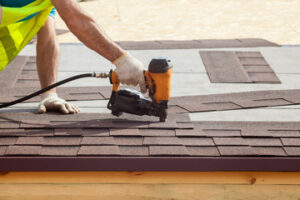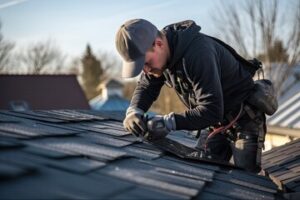A roof is a complex system of interrelated parts. Each component has a different function, but they all work together to create a sturdy, functional, and aesthetically appealing structure.

Before the contractors start laying down the new shingles, they will put down tarps to protect your landscaping features from debris and set up their ladders. They will also measure the height and length of the roof. Speak with J&M Elite Contractors for quality solutions.
Your roof isn’t just a shelter from the elements; it’s a testament to the deep connection between humanity and nature, a sturdy fortress that guards against the fury of storms, absorbs the sun’s warmth during summer and deflects its intensity in winter, all while gracefully accentuating the beauty of your sanctuary below. This fortitude is the result of meticulous craftsmanship, a seamless integration of materials that whisper defiance to nature’s forces and promise unwavering protection and durability. With each glance upward, you are awed by the thoughtful intricacies that transcend merely shelter to become a statement of style.
While roof installation is a necessary home improvement, it can pose a risk to your garden and exterior landscaping. To minimize this risk, a few preventative measures should be taken before the roofing project begins. These simple actions can protect your landscaping and garden from damage, ensure a safe work environment for contractors and minimize the risk of injuries or accidents that may occur near your home.
Before your roofing project starts, be sure to cover the areas surrounding your house with tarps or plastic sheeting. This will shield the plants and landscape from dust, debris and discarded material. It’s also a good idea to move any outdoor furniture or potted plants away from the construction area. This will help reduce the risk of damage or dislodgement during hammering and nailing operations.
Additionally, be sure to mow your lawn to the minimum height possible before the project begins. This will prevent any potential nails from escaping during the project and being concealed in long grass. Finally, be sure to shut down any automatic sprinkler systems a day or two before the beginning of the roof job to avoid any unnecessary water damage to your yard and landscaping.
It’s also a good idea to place visible warning signs near the work area to notify people of the potential hazards. This will help keep them and the workers safe and minimize the risk of injuries or accidents caused by falling debris during the project. In addition, there are several safety resources available to the roofing industry that can help improve worker safety, including a fall prevention plan template, a ladder safety mobile application, infographics and tipsheets, toolbox talks, and videos and webinars on working safely at heights.
Energy Efficiency
A new roof is not only a great way to make your home more beautiful and protect it from the elements, but it can also help to improve your energy efficiency. A roof that reflects solar rays rather than absorbing them will keep your house cooler and reduce the amount of time your air conditioner needs to work, saving you money every month on your utility bills.
Energy efficient roofs also extend the life of your cooling systems by keeping them from overworking. This helps you save money on repairs and maintenance, and can even allow your system to last longer before it has to be replaced. Plus, you can save even more on your energy costs with tax credits and rebates available for homeowners who choose to install energy-efficient roofs.
During the summer, your utility bills can spike dramatically as you use your AC to combat the heat. A new energy efficient roof can help you to cut those bills significantly, since it will attract less heat and force your air conditioner to work fewer hours. In addition, energy-efficient roofs can also help to cut your energy consumption overall and reduce greenhouse gas emissions.
A key factor in the effectiveness of any roofing material is how it is installed. It is important that a trained professional applies the material correctly to ensure the best results, and this includes using the proper fasteners. This will reduce leaks and improve the overall performance of the roof. The installation process should also include an inspection to check for leak areas and properly secured edges.
Other factors to consider when choosing a roofing material for your energy efficient home are its insulation value and solar reflectivity. Typically, a well-installed energy-efficient roof will have an R-value of 20 or more, which provides good thermal protection and increased energy efficiency. Similarly, a tile roof with an above sheathing vent will reduce energy costs by creating a space between the tiles and sheathing that prevents direct sunlight from heating the attic. Lastly, installing an energy efficient roof will increase the resale value of your home and can even qualify you for certain government incentives to offset the initial investment.
Curb Appeal
Whether you’re interested in selling your home or you simply want to impress guests and neighbors, curb appeal is one of the best ways to boost your property value. Homes that have attractive exteriors make a good first impression on potential buyers and create an emotional connection, which makes them more likely to pay a premium price.
A new roof is a major improvement that significantly enhances your curb appeal. Older roofs may be sagging, faded, or dirty, and they can make your entire house look weathered and unkempt. By contrast, a new roof is bright and clean and will instantly give your home an upgraded appearance.
In addition to your new roof, there are a number of other things you can do to improve your curb appeal. For example, you can replace your mailbox or planter boxes with a more attractive model. You can also install decorative molding around your doorway to add definition and beauty. These are simple improvements that you can complete yourself or with the help of a professional.
Another way to increase your curb appeal is by adding a fresh coat of paint. This is a relatively inexpensive project that can have a significant impact on your home’s visual appeal. You can choose from a wide range of colors and styles to suit your style preferences.
The final way to improve your curb appeal is by adding some landscaping. This is a great project that can be completed in a single day or weekend. It’s important to choose plants that are well-suited to your climate and soil conditions. You should also consider adding some bushes and trees to your yard to provide some color and privacy.
A new roof, a fresh coat of paint, and some updated landscaping can do wonders for your curb appeal. A well-maintained and attractive exterior will help you enjoy your home for years to come. It will also increase your property value and make it easier to sell if you decide to move. It’s worth taking the time to improve your curb appeal because it will provide a sense of pride every time you walk by or drive by your home.
Maintenance
The first thing the crew does is clear away any debris or leftover materials from the roof. They’ll remove the old shingles, the flashing, and the underlayment (if there is one). They’ll also clear away a soot-like substance called creosote from chimneys. Leaving this material on the chimney can lead to water damage and even leaks inside your home. This is why it’s important to clean chimneys and gutters seasonally.
Then the crew will take a look at the interior of your home for any signs of water damage. This includes mold, mildew, water stains, and even rotted beams or trusses. If any of this damage is found, the crew will need to repair or replace it before the roof installation can begin.
They’ll also do a thorough inspection of the flashing and sealant around chimneys, skylights, and vents. These areas are particularly vulnerable to water damage, and they’re usually the source of a lot of leaks in homes. If they see any signs of deterioration or cracking, the crew will need to replace them as soon as possible.
Once the sheathing and roof decking are installed, the crew will start putting in new shingles. Then they’ll install the roof ridge cap and finish it with shingles along the edges of the house. They’ll also install a drip edge to help keep water from pooling on the roof and causing leaks or other damage.
The final step is to apply a waterproof sealant to any raw edges. The crew will also check the sheathing and roof decking for any signs of moisture damage. This is the best way to prevent future leaks and other problems.
While a new roof can provide substantial benefits to your home, it’s not something you want to ignore. It takes very little time for small cracks and leaks to become serious issues that require costly repairs. It’s crucial to have your roof regularly inspected and repaired, especially in the fall and spring. By doing this, you can avoid major damage and save money in the long run.


